
- The Contents
- The Making of
- Where Are They Now
- Frequently Asked Questions
- Q & A with Ed Stone

golden record
Where are they now.
- frequently asked questions
- Q&A with Ed Stone
Galleries of Images Voyager Took
The Voyager 1 and 2 spacecraft explored Jupiter, Saturn, Uranus and Neptune before starting their journey toward interstellar space. Here you'll find some of those iconic images, including "The Pale Blue Dot" - famously described by Carl Sagan - and what are still the only up-close images of Uranus and Neptune.
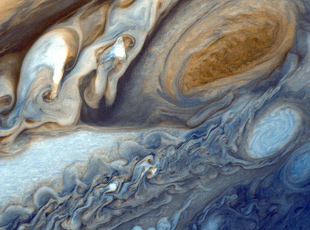
Photography of Jupiter began in January 1979, when images of the brightly banded planet already exceeded the best taken from Earth. Voyager 1 completed its Jupiter encounter in early April, after taking almost 19,000 pictures and many other scientific measurements. Voyager 2 picked up the baton in late April and its encounter continued into August. They took more than 33,000 pictures of Jupiter and its five major satellites.
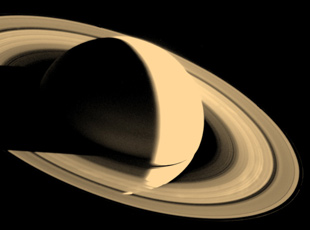
The Voyager 1 and 2 Saturn encounters occurred nine months apart, in November 1980 and August 1981. Voyager 1 is leaving the solar system. Voyager 2 completed its encounter with Uranus in January 1986 and with Neptune in August 1989, and is now also en route out of the solar system.
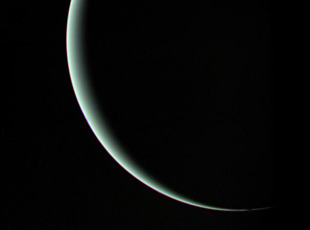
NASA's Voyager 2 spacecraft flew closely past distant Uranus, the seventh planet from the Sun, in January. At its closet, the spacecraft came within 81,800 kilometers (50,600 miles) of Uranus's cloudtops on Jan. 24, 1986. Voyager 2 radioed thousands of images and voluminous amounts of other scientific data on the planet, its moons, rings, atmosphere, interior and the magnetic environment surrounding Uranus.
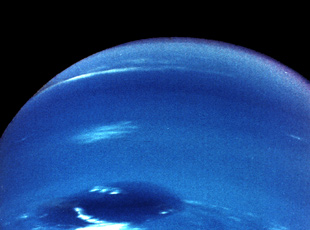
In the summer of 1989, NASA's Voyager 2 became the first spacecraft to observe the planet Neptune, its final planetary target. Passing about 4,950 kilometers (3,000 miles) above Neptune's north pole, Voyager 2 made its closest approach to any planet since leaving Earth 12 years ago. Five hours later, Voyager 2 passed about 40,000 kilometers (25,000 miles) from Neptune's largest moon, Triton, the last solid body the spacecraft will have an opportunity to study.
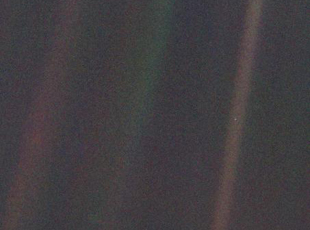
This narrow-angle color image of the Earth, dubbed 'Pale Blue Dot', is a part of the first ever 'portrait' of the solar system taken by Voyager 1. The spacecraft acquired a total of 60 frames for a mosaic of the solar system from a distance of more than 4 billion miles from Earth and about 32 degrees above the ecliptic. From Voyager's great distance Earth is a mere point of light, less than the size of a picture element even in the narrow-angle camera. Earth was a crescent only 0.12 pixel in size. Coincidentally, Earth lies right in the center of one of the scattered light rays resulting from taking the image so close to the sun. This blown-up image of the Earth was taken through three color filters -- violet, blue and green -- and recombined to produce the color image. The background features in the image are artifacts resulting from the magnification.
Uranus as seen by NASA's Voyager 2

This is an image of the planet Uranus taken by the spacecraft Voyager 2 in 1986. The Voyager project is managed for NASA by the Jet Propulsion Laboratory.
Keep Exploring
- VG Imaging Science Subsystem - Narrow Angle

Uranus as seen by NASA’s Voyager 2
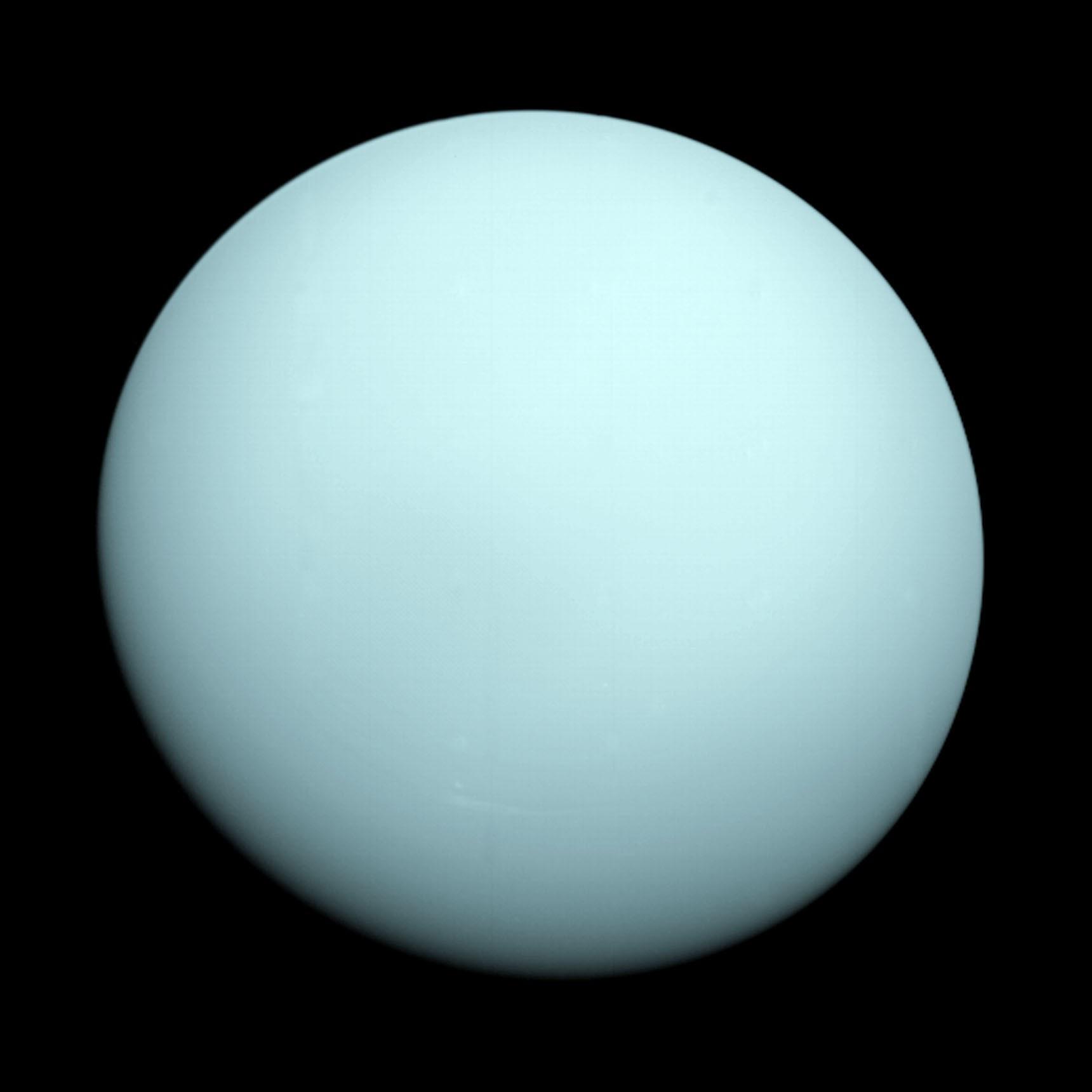
This is an image of the planet Uranus taken by the spacecraft Voyager 2 on January 14th 1986 from a distance of approximately 7.8 milllion miles ( 12.7 million km ).
Uranus as seen by NASA’s Voyager 2
(tif) (8.47 MB)
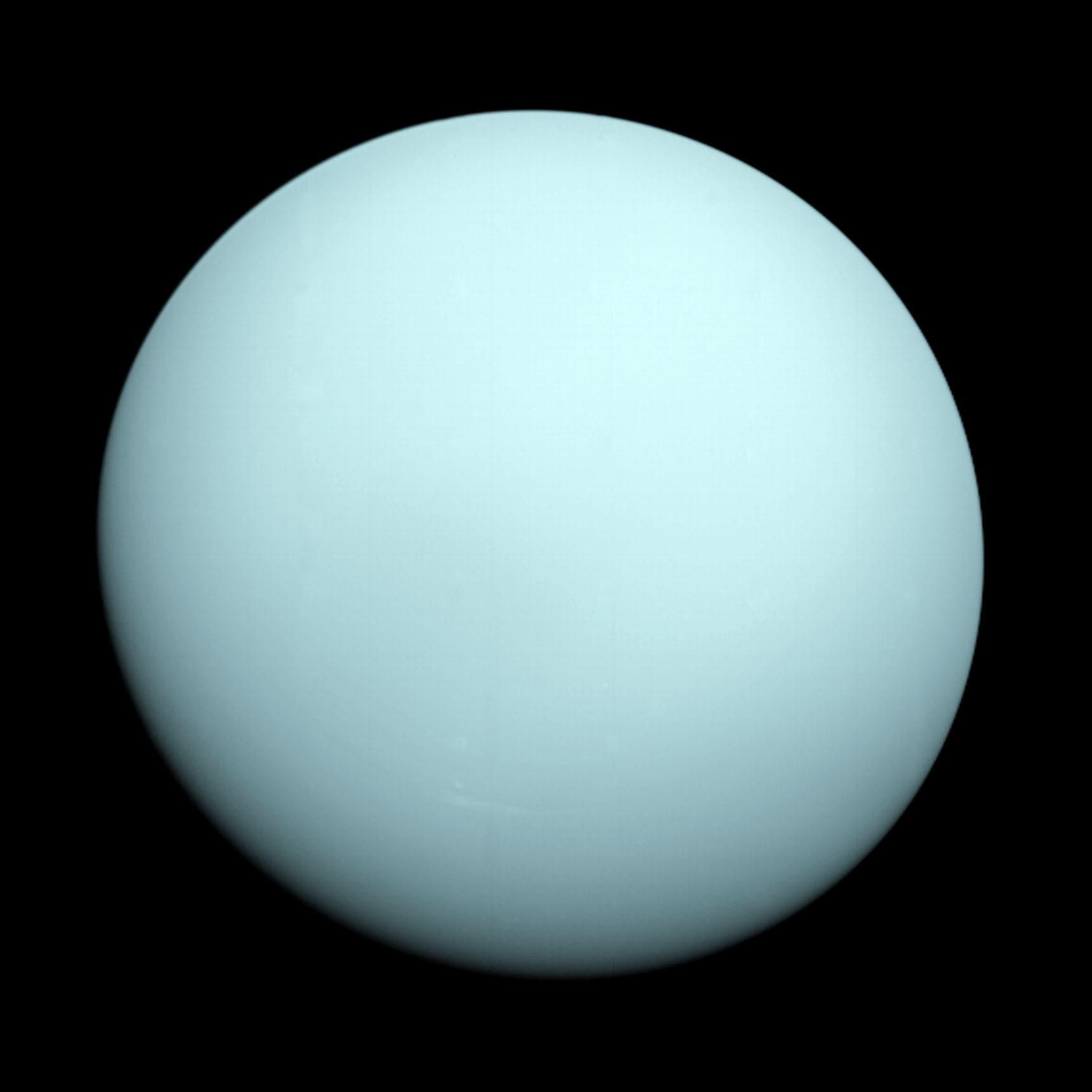
(jpg) (76.97 KB)
Voyager 2: An iconic spacecraft that's still exploring 45 years on
The interstellar vagabond continues to explore the cosmos along with its twin, Voyager 1.
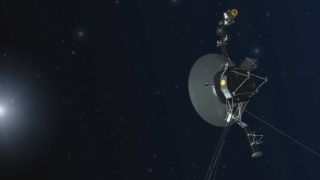
Voyager 2 as the backup
Jupiter and saturn flyby, uranus and neptune flyby, voyager 2's interstellar adventure, voyager 2's legacy, additional information.
Voyager 2, was the first of two twin probes NASA sent to investigate the outer planets of our solar system.
The probe was launched aboard a Titan IIIE-Centaur from Cape Canaveral Space Launch Complex 41 (previously Launch Complex 41) on Aug. 20, 1977, its twin spacecraft Voyager 1 was launched about two weeks later on Sept. 5. NASA planned for the Voyager spacecraft to take advantage of an alignment of the outer planets that takes place only every 176 years. The alignment would allow both probes to swing from one planet to the next, with a gravity boost to help them along the way.
While Voyager 1 focused on Jupiter and Saturn , Voyager 2 visited both those planets and also ventured to Uranus and Neptune. Voyager 2's mission to those last two planets would be humanity's only visit in the 20th century.
Related: Celebrate 45 years of Voyager with these amazing images of our solar system (gallery)
Voyager 2 is now traveling through interstellar space. As of early November 2018, NASA announced that Voyager 2 had crossed the outer edge of our solar system ( Voyager 1 crossed the boundary into interstellar space in 2012. ) Voyager 2 is now approximately 12 billion miles (19 billion kilometers) away from Earth and counting!
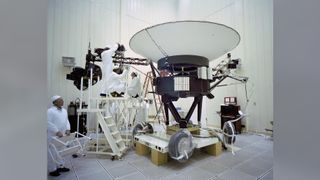
Although there was not enough money in Voyager 2's budget to guarantee it would still work when flying past Uranus and Neptune, its trajectory was designed to go past those planets anyway. If the spacecraft were still working after Saturn, NASA could try to take pictures of the other planets.
Voyager 2 was ready as a backup for Voyager 1. If Voyager 1 failed when taking pictures of Jupiter and Saturn, NASA was prepared to alter Voyager 2's path to follow Voyager 1's trajectory. It would cut off the Uranus and Neptune option, but still, preserve the possibility of capturing images.
The backup plan was never executed, though, because Voyager 1 went on to make many discoveries at Jupiter and Saturn, working well enough for NASA to carry out its original plans for Voyager 2.
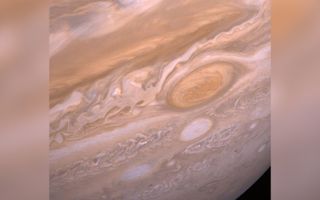
Voyager 2 reached Jupiter in 1979, two years after launching from Cape Canaveral. Since Voyager 1 had just gone through the system four months earlier, Voyager 2's arrival allowed NASA to take valuable comparison shots of Jupiter and its moons. It captured changes in the Great Red Spot and also resolved some of the moon's surfaces in greater detail.
Voyager 2 took pictures of many of Jupiter's satellites. Among its most spectacular findings were pictures from the icy moon Europa . Voyager 2 snapped detailed photos of the icy moon's cracks from 128,000 miles (205,996 km) away and revealed no change in elevation anywhere on the moon's surface.
Proving that moons are abundant around the outer planets, Voyager 2 happened to image Adrastea, a small moon of Jupiter, only months after Voyager 1 found two other Jupiter moons, Thebe and Metis. Adrastea is exceptionally small, only about 19 miles (30.5 kilometers) in diameter at the smallest estimate.
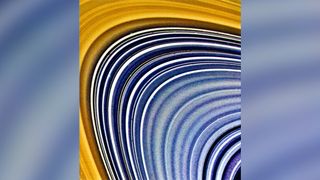
Next in line was Saturn. Voyager 2 became the third spacecraft to visit Saturn when it arrived at its closest point to the ringed planet on Aug. 26, 1981, and took hundreds of pictures of the planet, its moons and its rings . Suspecting that Saturn might be circled by many ringlets, scientists conducted an experiment. They watched the star Delta Scorpii for nearly two and a half hours as it passed through the plane of the rings. As expected, the star's flickering light revealed ringlets as small as 330 feet (100 meters) in diameter.
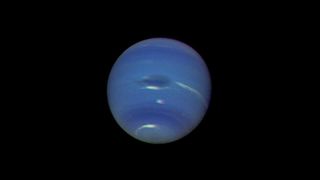
Voyager 2's made its closest approach to Uranus on Jan. 24, 1986, becoming the first spacecraft to visit the ice giant. The probe made several observations of the planet, noting that the south pole was facing the sun and that its atmosphere is about 85% hydrogen and 15% helium.
Additionally, Voyager 2 discovered rings around Uranus, 10 new moons and a magnetic field that, oddly, was 55 degrees off the planet's axis. Astronomers are still puzzling over Uranus' orientation today.
Voyager 2's pictures of the moon Miranda revealed it to be perhaps the strangest moon in the solar system. Its jumbled-up surface appears as though it was pushed together and broken apart several times.
The spacecraft then made it to Neptune , reaching the closest point on Aug. 25, 1989. It skimmed about 3,000 miles from the top of the planet's atmosphere and spotted five new moons as well as four rings around the planet. Remarkably, Voyager 2 is currently the only human-made object to have flown by the intriguing ice giant, according to NASA .
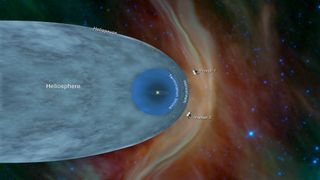
On November 5, 2018, Voyager 2 crossed the heliopause — the boundary between the heliosphere and interstellar space. At this stage, the probe was 119 astronomical units from the sun. (One AU is the average Earth-sun distance, which is about 93 million miles, or 150 million kilometers.) Voyager 1 made the crossing at nearly the same distance, 121.6 AU.
According to NASA Jet Propulsion Laboratory (JPL) , Voyager 2 has enough fuel to keep its instruments running until at least 2025. By then, the spacecraft will be approximately 11.4 billion miles (18.4 billion kilometers) away from the sun.
But Voyager 2 is destined to roam the Milky Way long after its instruments have stopped working.
In about 40,000 years Voyager 2 will pass 1.7 light-years (9.7 trillion miles) from the star Ross 248, according to NASA JPL. The cosmic vagabond will continue its journey through interstellar space and pass 4.3 light-years, (25 trillion miles) from Sirius in about 296,000 years.
Voyager 2's observations paved the way for later missions. The Cassini spacecraft, which was at Saturn between 2004 and 2017, tracked down evidence of liquid water at the planet's icy moons several decades after the Voyagers initially revealed the possible presence of water. Cassini also mapped the moon, Titan , after the Voyagers took pictures of its thick atmosphere.
Voyager 2's images of Uranus and Neptune also serve as a baseline for current observations of those giant planets. In 2014, astronomers were surprised to see giant storms on Uranus — a big change from when Voyager 2 flew by the planet in 1986.
To see where Voyager 2 is now you can check out the mission status with resources from NASA . Learn more about the iconic spacecraft with the National Air and Space Museum .
Bibliography
NASA. In depth: Voyager 2. NASA. Retrieved August 17, 2022, from www.solarsystem.nasa.gov/missions/voyager-2/in-depth/
NASA. Voyager - mission status. NASA. Retrieved August 17, 2022, from www.voyager.jpl.nasa.gov/mission/status/
NASA. Voyager - the interstellar mission. NASA. Retrieved August 17, 2022, from www. voyager.jpl.nasa.gov/mission/interstellar-mission
Join our Space Forums to keep talking space on the latest missions, night sky and more! And if you have a news tip, correction or comment, let us know at: [email protected].
Get the Space.com Newsletter
Breaking space news, the latest updates on rocket launches, skywatching events and more!

Elizabeth Howell (she/her), Ph.D., is a staff writer in the spaceflight channel since 2022 covering diversity, education and gaming as well. She was contributing writer for Space.com for 10 years before joining full-time. Elizabeth's reporting includes multiple exclusives with the White House and Office of the Vice-President of the United States, an exclusive conversation with aspiring space tourist (and NSYNC bassist) Lance Bass, speaking several times with the International Space Station, witnessing five human spaceflight launches on two continents, flying parabolic, working inside a spacesuit, and participating in a simulated Mars mission. Her latest book, " Why Am I Taller ?", is co-written with astronaut Dave Williams. Elizabeth holds a Ph.D. and M.Sc. in Space Studies from the University of North Dakota, a Bachelor of Journalism from Canada's Carleton University and a Bachelor of History from Canada's Athabasca University. Elizabeth is also a post-secondary instructor in communications and science at several institutions since 2015; her experience includes developing and teaching an astronomy course at Canada's Algonquin College (with Indigenous content as well) to more than 1,000 students since 2020. Elizabeth first got interested in space after watching the movie Apollo 13 in 1996, and still wants to be an astronaut someday. Mastodon: https://qoto.org/@howellspace
- Daisy Dobrijevic Reference Editor
SpaceX fires up Starship rocket for upcoming 5th test flight (photos, video)
Blinded by the light: How bad are satellite megaconstellations for astronomy?
Scientists use XRISM spacecraft to predict fate of matter around monster supermassive black hole
Most Popular
- 2 China's Chang'e 6 probe to the moon's far side has a big lunar mystery to solve
- 3 4 large incoming solar bursts could supercharge the auroras this weekend
- 4 Sierra Space's 1st Dream Chaser space plane aces key tests. Next stop: Florida launch site.
- 5 NASA's Nancy Grace Roman Telescope will hunt for tiny black holes left over from the Big Bang
For IEEE Members
Ieee spectrum, follow ieee spectrum, support ieee spectrum, enjoy more free content and benefits by creating an account, saving articles to read later requires an ieee spectrum account, the institute content is only available for members, downloading full pdf issues is exclusive for ieee members, downloading this e-book is exclusive for ieee members, access to spectrum 's digital edition is exclusive for ieee members, following topics is a feature exclusive for ieee members, adding your response to an article requires an ieee spectrum account, create an account to access more content and features on ieee spectrum , including the ability to save articles to read later, download spectrum collections, and participate in conversations with readers and editors. for more exclusive content and features, consider joining ieee ., join the world’s largest professional organization devoted to engineering and applied sciences and get access to all of spectrum’s articles, archives, pdf downloads, and other benefits. learn more →, join the world’s largest professional organization devoted to engineering and applied sciences and get access to this e-book plus all of ieee spectrum’s articles, archives, pdf downloads, and other benefits. learn more →, access thousands of articles — completely free, create an account and get exclusive content and features: save articles, download collections, and talk to tech insiders — all free for full access and benefits, join ieee as a paying member., how nasa is hacking voyager 1 back to life, engineers found space in the geriatric spacecraft’s memory to deal with a stuck bit.

Voyager 1 whizzes through interstellar space at 17 kilometers per second.
On 14 November 2023, NASA’s interstellar space probe Voyager 1 began sending gibberish back to Earth. For five months, the spacecraft transmitted unusable data equivalent to a dial tone.
In March, engineers discovered the cause of the communication snafu: a stuck bit in one of the chips comprising part of Voyager’s onboard memory. The chip contained lines of code used by the flight data subsystem (FDS), one of three computers aboard the spacecraft and the one that is responsible for collecting and packaging data before sending it back to Earth.
JPL engineers sent a command through the Deep Space Network on 18 April to relocate the affected section of code to another part of the spacecraft’s memory, hoping to fix the glitch in the archaic computer system. Roughly 22.5 hours later, the radio signal reached Voyager in interstellar space, and by the following day it was clear the command had worked. Voyager began returning useful data again on 20 April.
NASA engineers managed to diagnose and repair Voyager 1 from 24 billion kilometers away—all while working within the constraints of the vintage technology. “We had some people left that we could rely on [who] could remember working on bits of the hardware,” says project scientist Linda Spilker . “But a lot of it was going back through old memos, like an archeological dig to try and find information on the best way to proceed.”
Minuscule Memory
Voyager 1 and its twin, Voyager 2—which also remains operational—were launched nearly 50 years ago, in 1977, to tour the solar system. Both spacecraft far surpassed their original missions of visiting Jupiter and Saturn, and in 2012, entered interstellar space .
“That mission literally rewrote the textbooks on the solar system,” says Jim Bell , a planetary scientist at Arizona State University and author of a book recounting 40 years of the mission. “We’ve never sent anything out that far, so every bit of data they send back is new.” The 1960s and 1970s technology, on the other hand, is now ancient.
Decades after the tech went out of vogue, the FDS still uses assembly language and 16-bit words . “These are two positively geriatric spacecraft,” says Todd Barber , a propulsion engineer for Voyager. Working to fix the issues, he says, is “like palliative care.”
To first diagnose the issue, NASA’s engineers first tried turning on and off different instruments, says Spilker. When that proved unsuccessful, they initiated a full memory readout of the FDS. “That’s what led to us finding that piece of hardware that had failed and that 256-bit chunk of memory,” she says. In one chip, the engineers found a stuck bit, fixed at the same binary value. It became clear that the chip was irreparable, so the team had to identify and relocate the affected code.
However, no single location was large enough to accommodate the extra 256 bits. “The size of the memory was the biggest challenge in this anomaly,” says Spilker. Voyager’s computers each have a mere 69.63 kilobytes of memory.
To begin fixing the issue, the team searched for corners of Voyager’s memory to place segments of code that would allow for the return of engineering data, which includes information about the status of science instruments and the spacecraft itself. One way the engineers freed up extra space was by identifying processes no longer used. For example, Voyager was programmed with several data modes—the rate at which data is sent back to Earth—because the spacecraft could transmit data much faster when it was closer to Earth. At Jupiter, the spacecraft transmitted data at 115.2 kilobits per second; now, that rate has slowed to 40 bits per second, and faster modes can be overwritten. However, the engineers have to be careful to ensure they don’t delete code that is used by multiple data modes.
Having successfully returned engineering data, the team is working to relocate the rest of the affected code in the coming weeks. “We’re having to look a little harder to find the space and make some key decisions about what to overwrite,” says Spilker. When their work is completed, the Voyager team hopes to return new science data, though unfortunately, all data from the anomaly period was lost.
Built to Last
The cause of the stuck bit is a mystery, but it’s likely the chip either wore out with age or was hit by a highly energetic particle from a cosmic ray. Having entered interstellar space, “Voyager is out bathed in the cosmic rays,” Spilker says. Luckily, the spacecraft was built to take it, with its electronic components shielded from the large amount of radiation present at Jupiter. “That’s serving us quite well now in the interstellar medium.”
When Voyager was built, the 12-year trip to Uranus and Neptune alone was a “seemingly impossible goal for a 1977 launch,” says Barber. The longevity of Voyager is a testament of its engineering, which accounted for many contingencies and added redundancy. The mission also included several firsts, for example, as the first spacecraft with computers able to hold data temporarily using volatile CMOS memory. (An 8-track digital tape recorder onboard stores data when collected at a high rate.)
Importantly, it was also the first mission with a reprogrammable computer. “We take it for granted now,” Bell says, but before Voyager, it wasn’t possible to adjust software in-flight. This capability proved essential when the mission was extended, as well as when issues arise.
Going forward, the Voyager team expects to encounter additional problems in the aging spacecraft—though they hope to make it to the 50-year anniversary before the next one. “With each anomaly, we just learn more about how to work with the spacecraft and are just amazed at the capabilities that the engineers built into it using that 1960s and ’70s technology,” Spilker says. “It’s just amazing.”
- 50 Years Later, This Apollo-Era Antenna Still Talks to Voyager 2 ›
- Voyager 1 Hasn't Really Left The Solar System, But That's OK ›
- Mission Status - Voyager ›
- Voyager 1 ›
Gwendolyn Rak is a contributor to IEEE Spectrum .
The New Shadow Hand Can Take a Beating
Commercial space stations approach launch phase, management versus technical track, related stories, satellite radar sharpens ukraine dam collapse questions, the most hackable handheld ham radio yet, faster, more secure photonic chip boosts ai training.
Inside NASA's 5-month fight to save the Voyager 1 mission in interstellar space

After working for five months to re-establish communication with the farthest-flung human-made object in existence, NASA announced this week that the Voyager 1 probe had finally phoned home.
For the engineers and scientists who work on NASA’s longest-operating mission in space, it was a moment of joy and intense relief.
“That Saturday morning, we all came in, we’re sitting around boxes of doughnuts and waiting for the data to come back from Voyager,” said Linda Spilker, the project scientist for the Voyager 1 mission at NASA’s Jet Propulsion Laboratory in Pasadena, California. “We knew exactly what time it was going to happen, and it got really quiet and everybody just sat there and they’re looking at the screen.”
When at long last the spacecraft returned the agency’s call, Spilker said the room erupted in celebration.
“There were cheers, people raising their hands,” she said. “And a sense of relief, too — that OK, after all this hard work and going from barely being able to have a signal coming from Voyager to being in communication again, that was a tremendous relief and a great feeling.”

The problem with Voyager 1 was first detected in November . At the time, NASA said it was still in contact with the spacecraft and could see that it was receiving signals from Earth. But what was being relayed back to mission controllers — including science data and information about the health of the probe and its various systems — was garbled and unreadable.
That kicked off a monthslong push to identify what had gone wrong and try to save the Voyager 1 mission.
Spilker said she and her colleagues stayed hopeful and optimistic, but the team faced enormous challenges. For one, engineers were trying to troubleshoot a spacecraft traveling in interstellar space , more than 15 billion miles away — the ultimate long-distance call.
“With Voyager 1, it takes 22 1/2 hours to get the signal up and 22 1/2 hours to get the signal back, so we’d get the commands ready, send them up, and then like two days later, you’d get the answer if it had worked or not,” Spilker said.

The team eventually determined that the issue stemmed from one of the spacecraft’s three onboard computers. Spilker said a hardware failure, perhaps as a result of age or because it was hit by radiation, likely messed up a small section of code in the memory of the computer. The glitch meant Voyager 1 was unable to send coherent updates about its health and science observations.
NASA engineers determined that they would not be able to repair the chip where the mangled software is stored. And the bad code was also too large for Voyager 1's computer to store both it and any newly uploaded instructions. Because the technology aboard Voyager 1 dates back to the 1960s and 1970s, the computer’s memory pales in comparison to any modern smartphone. Spilker said it’s roughly equivalent to the amount of memory in an electronic car key.
The team found a workaround, however: They could divide up the code into smaller parts and store them in different areas of the computer’s memory. Then, they could reprogram the section that needed fixing while ensuring that the entire system still worked cohesively.
That was a feat, because the longevity of the Voyager mission means there are no working test beds or simulators here on Earth to test the new bits of code before they are sent to the spacecraft.
“There were three different people looking through line by line of the patch of the code we were going to send up, looking for anything that they had missed,” Spilker said. “And so it was sort of an eyes-only check of the software that we sent up.”
The hard work paid off.
NASA reported the happy development Monday, writing in a post on X : “Sounding a little more like yourself, #Voyager1.” The spacecraft’s own social media account responded , saying, “Hi, it’s me.”
So far, the team has determined that Voyager 1 is healthy and operating normally. Spilker said the probe’s scientific instruments are on and appear to be working, but it will take some time for Voyager 1 to resume sending back science data.
Voyager 1 and its twin, the Voyager 2 probe, each launched in 1977 on missions to study the outer solar system. As it sped through the cosmos, Voyager 1 flew by Jupiter and Saturn, studying the planets’ moons up close and snapping images along the way.
Voyager 2, which is 12.6 billion miles away, had close encounters with Jupiter, Saturn, Uranus and Neptune and continues to operate as normal.
In 2012, Voyager 1 ventured beyond the solar system , becoming the first human-made object to enter interstellar space, or the space between stars. Voyager 2 followed suit in 2018.
Spilker, who first began working on the Voyager missions when she graduated college in 1977, said the missions could last into the 2030s. Eventually, though, the probes will run out of power or their components will simply be too old to continue operating.
Spilker said it will be tough to finally close out the missions someday, but Voyager 1 and 2 will live on as “our silent ambassadors.”
Both probes carry time capsules with them — messages on gold-plated copper disks that are collectively known as The Golden Record . The disks contain images and sounds that represent life on Earth and humanity’s culture, including snippets of music, animal sounds, laughter and recorded greetings in different languages. The idea is for the probes to carry the messages until they are possibly found by spacefarers in the distant future.
“Maybe in 40,000 years or so, they will be getting relatively close to another star,” Spilker said, “and they could be found at that point.”
Denise Chow is a reporter for NBC News Science focused on general science and climate change.
- Become A Member
- Gift Membership
- Kids Membership
- Other Ways to Give
- Explore Worlds
- Defend Earth
How We Work
- Education & Public Outreach
- Space Policy & Advocacy
- Science & Technology
- Global Collaboration
Our Results
Learn how our members and community are changing the worlds.
Our citizen-funded spacecraft successfully demonstrated solar sailing for CubeSats.
Space Topics
- Planets & Other Worlds
- Space Missions
- Space Policy
- Planetary Radio
- Space Images
The Planetary Report
The eclipse issue.
Science and splendor under the shadow.
Get Involved
Membership programs for explorers of all ages.
Get updates and weekly tools to learn, share, and advocate for space exploration.
Volunteer as a space advocate.
Support Our Mission
- Renew Membership
- Society Projects
The Planetary Fund
Accelerate progress in our three core enterprises — Explore Worlds, Find Life, and Defend Earth. You can support the entire fund, or designate a core enterprise of your choice.
- Strategic Framework
- News & Press
The Planetary Society
Know the cosmos and our place within it.
Our Mission
Empowering the world's citizens to advance space science and exploration.
- Explore Space
- Take Action
- Member Community
- Account Center
- “Exploration is in our nature.” - Carl Sagan
Bruce Murray Space Image Library
Voyager 2's Last Image of Uranus
For full functionality of this site it is necessary to enable JavaScript. Here are instructions on how to enable JavaScript in your web browser .

Suggested Searches
- Climate Change
- Expedition 64
- Mars perseverance
- SpaceX Crew-2
- International Space Station
- View All Topics A-Z
Humans in Space
Earth & climate, the solar system, the universe, aeronautics, learning resources, news & events.

How NASA’s Roman Mission Will Hunt for Primordial Black Holes


International SWOT Mission Can Improve Flood Prediction

New NASA Black Hole Visualization Takes Viewers Beyond the Brink
- Search All NASA Missions
- A to Z List of Missions
- Upcoming Launches and Landings
- Spaceships and Rockets
- Communicating with Missions
- James Webb Space Telescope
- Hubble Space Telescope
- Why Go to Space
- Astronauts Home
- Commercial Space
- Destinations
- Living in Space
- Explore Earth Science
- Earth, Our Planet
- Earth Science in Action
- Earth Multimedia
- Earth Science Researchers
- Pluto & Dwarf Planets
- Asteroids, Comets & Meteors
- The Kuiper Belt
- The Oort Cloud
- Skywatching
- The Search for Life in the Universe
- Black Holes
- The Big Bang
- Dark Energy & Dark Matter
- Earth Science
- Planetary Science
- Astrophysics & Space Science
- The Sun & Heliophysics
- Biological & Physical Sciences
- Lunar Science
- Citizen Science
- Astromaterials
- Aeronautics Research
- Human Space Travel Research
- Science in the Air
- NASA Aircraft
- Flight Innovation
- Supersonic Flight
- Air Traffic Solutions
- Green Aviation Tech
- Drones & You
- Technology Transfer & Spinoffs
- Space Travel Technology
- Technology Living in Space
- Manufacturing and Materials
- Science Instruments
- For Kids and Students
- For Educators
- For Colleges and Universities
- For Professionals
- Science for Everyone
- Requests for Exhibits, Artifacts, or Speakers
- STEM Engagement at NASA
- NASA's Impacts
- Centers and Facilities
- Directorates
- Organizations
- People of NASA
- Internships
- Our History
- Doing Business with NASA
- Get Involved
- Aeronáutica
- Ciencias Terrestres
- Sistema Solar
- All NASA News
- Video Series on NASA+
- Newsletters
- Social Media
- Media Resources
- Upcoming Launches & Landings
- Virtual Events
- Sounds and Ringtones
- Interactives
- STEM Multimedia

NASA’s New Mobile Launcher Stacks Up for Future Artemis Missions

Hubble Celebrates the 15th Anniversary of Servicing Mission 4

Hubble Glimpses a Star-Forming Factory

NASA Mission Strengthens 40-Year Friendship

NASA Selects Commercial Service Studies to Enable Mars Robotic Science

NASA’s Commercial Partners Deliver Cargo, Crew for Station Science

NASA Is Helping Protect Tigers, Jaguars, and Elephants. Here’s How.

Two Small NASA Satellites Will Measure Soil Moisture, Volcanic Gases

C.26 Rapid Mission Design Studies for Mars Sample Return Correction and Other Documents Posted

NASA Selects Students for Europa Clipper Intern Program

The Big Event, 2024

NASA Images Help Explain Eating Habits of Massive Black Hole

NASA’s Webb Hints at Possible Atmosphere Surrounding Rocky Exoplanet

NASA Licenses 3D-Printable Superalloy to Benefit US Economy

ARMD Solicitations

NASA’s Commitment to Safety Starts with its Culture

Tech Today: NASA’s Ion Thruster Knowhow Keeps Satellites Flying

Big Science Drives Wallops’ Upgrades for NASA Suborbital Missions

NASA Challenge Gives Artemis Generation Coders a Chance to Shine

NASA Community College Aerospace Scholars

Ken Carpenter: Ensuring Top-Tier Science from Moon to Stars

White Sands Propulsion Team Tests 3D-Printed Orion Engine Component

A Different Perspective – Remembering James Dean, Founder of the NASA Art Program

Diez maneras en que los estudiantes pueden prepararse para ser astronautas

Astronauta de la NASA Marcos Berríos

Resultados científicos revolucionarios en la estación espacial de 2023
Nasa’s webb scores another ringed world with new image of uranus, nasa webb telescope team.
Following in the footsteps of the Neptune image released in 2022, NASA’s James Webb Space Telescope has taken a stunning image of the solar system’s other ice giant, the planet Uranus. The new image features dramatic rings as well as bright features in the planet’s atmosphere.
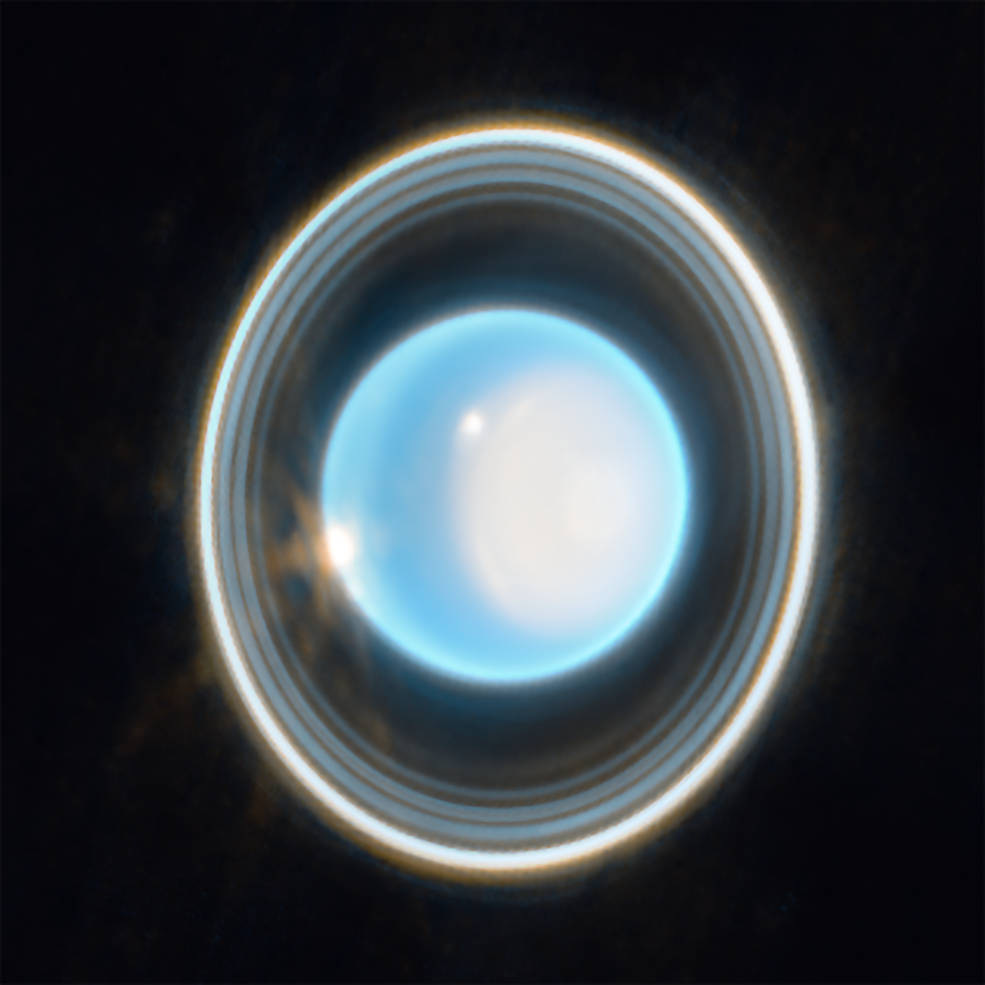
Download the full-resolution version from the Space Telescope Science Institute.
Following in the footsteps of the Neptune image released in 2022, NASA’s James Webb Space Telescope has taken a stunning image of the solar system’s other ice giant, the planet Uranus. The new image features dramatic rings as well as bright features in the planet’s atmosphere. The Webb data demonstrates the observatory’s unprecedented sensitivity for the faintest dusty rings, which have only ever been imaged by two other facilities: the Voyager 2 spacecraft as it flew past the planet in 1986, and the Keck Observatory with advanced adaptive optics.
The seventh planet from the Sun, Uranus is unique: It rotates on its side, at roughly a 90-degree angle from the plane of its orbit. This causes extreme seasons since the planet’s poles experience many years of constant sunlight followed by an equal number of years of complete darkness. (Uranus takes 84 years to orbit the Sun.) Currently, it is late spring for the northern pole, which is visible here; Uranus’ northern summer will be in 2028. In contrast, when Voyager 2 visited Uranus it was summer at the south pole. The south pole is now on the ‘dark side’ of the planet, out of view and facing the darkness of space.
This infrared image from Webb’s Near-Infrared Camera (NIRCam) combines data from two filters at 1.4 and 3.0 microns, which are shown here in blue and orange, respectively. The planet displays a blue hue in the resulting representative-color image.
When Voyager 2 looked at Uranus , its camera showed an almost featureless blue-green ball in visible wavelengths. With the infrared wavelengths and extra sensitivity of Webb we see more detail, showing how dynamic the atmosphere of Uranus really is.
On the right side of the planet there’s an area of brightening at the pole facing the Sun, known as a polar cap. This polar cap is unique to Uranus – it seems to appear when the pole enters direct sunlight in the summer and vanish in the fall; these Webb data will help scientists understand the currently mysterious mechanism. Webb revealed a surprising aspect of the polar cap: a subtle enhanced brightening at the center of the cap. The sensitivity and longer wavelengths of Webb’s NIRCam may be why we can see this enhanced Uranus polar feature when it has not been seen as clearly with other powerful telescopes like the Hubble Space Telescope and Keck Observatory.
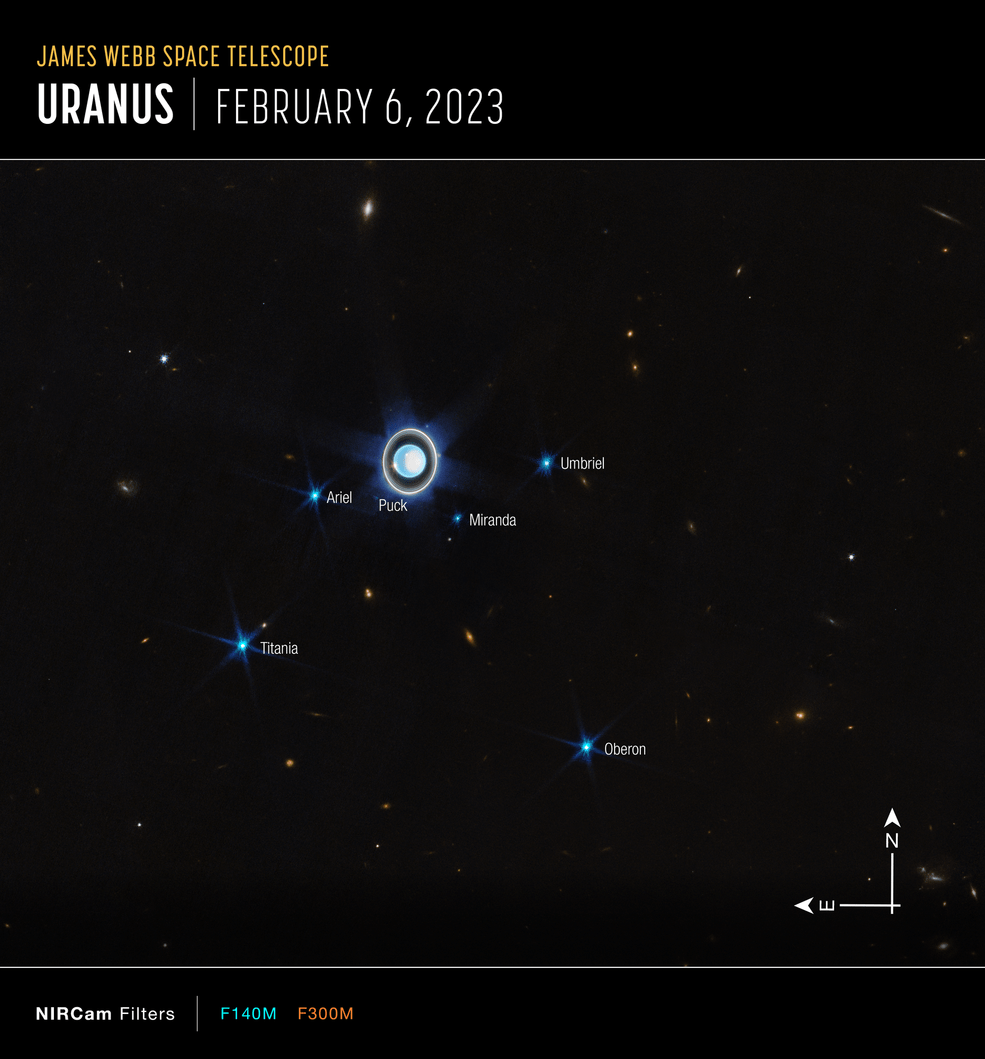
At the edge of the polar cap lies a bright cloud as well as a few fainter extended features just beyond the cap’s edge, and a second very bright cloud is seen at the planet’s left limb. Such clouds are typical for Uranus in infrared wavelengths, and likely are connected to storm activity.
This planet is characterized as an ice giant due to the chemical make-up of its interior. Most of its mass is thought to be a hot, dense fluid of “icy” materials – water, methane, and ammonia – above a small rocky core.
Uranus has 13 known rings and 11 of them are visible in this Webb image. Some of these rings are so bright with Webb that when they are close together, they appear to merge into a larger ring. Nine are classed as the main rings of the planet, and two are the fainter dusty rings (such as the diffuse zeta ring closest to the planet) that weren’t discovered until the 1986 flyby by Voyager 2. Scientists expect that future Webb images of Uranus will reveal the two faint outer rings that were discovered with Hubble during the 2007 ring-plane crossing.
Webb also captured many of Uranus’ 27 known moons (most of which are too small and faint to be seen here); the six brightest are identified in the wide-view image. This was only a short, 12-minute exposure image of Uranus with just two filters. It is just the tip of the iceberg of what Webb can do when observing this mysterious planet. In 2022, the National Academies of Sciences, Engineering, and Medicine identified Uranus science as a priority in its 2023-2033 Planetary Science and Astrobiology decadal survey . Additional studies of Uranus are happening now, and more are planned in Webb’s first year of science operations.
The James Webb Space Telescope is the world’s premier space science observatory. Webb will solve mysteries in our solar system, look beyond to distant worlds around other stars, and probe the mysterious structures and origins of our universe and our place in it. Webb is an international program led by NASA with its partners, ESA (European Space Agency) and the Canadian Space Agency.
Media Contacts:
Laura Betz NASA’s Goddard Space Flight Center, Greenbelt, Md. [email protected]
Christine Pulliam Space Telescope Science Institute, Baltimore, Md. [email protected]
- สมัคร / ล็อกอิน
- ความช่วยเหลือ

Air Force 1 x Tiffany & Co.
Air Force 1 เป็นที่รู้จักครั้งแรกในปี 1982 และสร้างนิยามใหม่ให้รองเท้าบาสเก็ตบอลตั้งแต่คอร์ทพื้นไม้ไปจนถึงพื้นคอนกรีต แถมยังเป็นสนีกเกอร์บาสเก็ตบอลคู่แรกที่ใช้ Nike Air แต่ความล้ำนวัตกรรมก็ยังต้องหลีกทางให้ความเป็นไอคอนในแนวสตรีทของรุ่นนี้


IMAGES
VIDEO
COMMENTS
NASA's Voyager 2 spacecraft flew closely past distant Uranus, the seventh planet from the Sun, in January. At its closet, the spacecraft came within 81,800 kilometers (50,600 miles) of Uranus's cloudtops on Jan. 24, 1986. Voyager 2 radioed thousands of images and voluminous amounts of other scientific data on the planet, its moons, rings ...
Voyager 2 completed its encounter with Uranus in January 1986 and with Neptune in August 1989, and is now also en route out of the solar system. Uranus NASA's Voyager 2 spacecraft flew closely past distant Uranus, the seventh planet from the Sun, in January. At its closet, the spacecraft came within 81,800 kilometers (50,600 miles) of Uranus's ...
Color Voyager 2 Image Showing Crescent Uranus Full Resolution: TIFF (231.9 kB) JPEG (17.76 kB) 1998-06-04: Enceladus: Voyager: VG ISS - Narrow Angle: 1004x1004x3: PIA00347: Voyager 2 Color Image of Enceladus, Almost ...
Dec. 18, 1986. This is an image of the planet Uranus taken by the spacecraft Voyager 2 in 1986. The Voyager project is managed for NASA by the Jet Propulsion Laboratory. Download JPG.
Uranus as seen by NASA's Voyager 2. December 18, 1986. Credit. NASA/JPL. PIA Number. PIA18182. Language. english. This is an image of the planet Uranus taken by the spacecraft Voyager 2 on January 14th 1986 from a distance of approximately 7.8 milllion miles ( 12.7 million km ).
Jan 22, 2021. Article. In January 1986, NASA's Voyager 2 became the first, and so far the only, spacecraft to explore Uranus, the second to last stop on its journey through the outer solar system. NASA's Jet Propulsion Laboratory in Pasadena, California, manages Voyagers 1 and 2, twin spacecraft launched in 1977 to explore the outer planets.
Uranus from Voyager 2 Voyager 2 saw Uranus as a near-featureless grey-green orb when it flew past the planet in 1986. NASA/JPL-Caltech. Most NASA images are in the public domain. Reuse of this image is governed by NASA's image use policy. Explore related images: Outer planets missions, Space missions, The Uranus system, Uranus, Voyager 1 and 2 ...
Arriving at Uranus in 1986, Voyager 2 observed a bluish orb with extremely subtle features. A haze layer hid most of the planet's clouds from view. ... Object Name: Uranus: Object Description: Gas giant: About The Data; Instrument: Voyager 2- Narrow Angle Camera: Exposure Dates: Jan. 24, 1986: Fast Facts Help About The Object; Object Name: A ...
Voyager 2 is a space probe launched by NASA on August 20, 1977, as a part of the Voyager program. It was launched on a trajectory toward the gas giants Jupiter and Saturn and enabled further encounters with the ice giants Uranus and Neptune.
Humanity has visited Uranus only once, and that was 30 years ago. NASA's Voyager 2 spacecraft got its closest look at the mysterious, distant, gaseous planet on Jan. 24, 1986. Voyager 2 sent back stunning images of the planet and its moons during the flyby, which allowed for about 5.5 hours of close study. The spacecraft got within 50,600 ...
Voyager 2 snapped detailed photos of the icy moon's cracks from 128,000 miles (205,996 km) away and revealed no change in elevation anywhere on the moon's surface. ... Voyager 2's images of Uranus ...
Target is Uranus (and available satellites) Go to PIAxxxxx: Refine this list of images by: Target: Mission: Spacecraft: Instrument: Click on an image for detailed information ... Uranus as seen by NASA's Voyager 2 Full Resolution: TIFF (8.879 MB) JPEG (78.82 kB) 1996-01-29: U Rings: Voyager: 399x500x3: PIA00033: Uranus Rings in False Color Full ...
Three decades later, scientists reinspecting that data found one more secret. Unbeknownst to the entire space physics community, 34 years ago Voyager 2 flew through a plasmoid, a giant magnetic bubble that may have been whisking Uranus's atmosphere out to space. The finding, reported in Geophysical Research Letters, raises new questions about ...
Only two Voyager 2 images contain clear views of Uranus' dusty ring system — or so we thought. Since Voyager 2's 1986 flyby, only ground-based telescopes have yielded views of the rings. Images taken by the W. M. Keck Observatory in 2007 suggested that one of the ice giant's dusty rings, the inner zeta ring, might have changed in ...
Voyager 1 continued toward the far reaches of our cosmic neighborhood, while Voyager 2 would first make historic swoops by Uranus and Neptune — the "ice giants." Again, the moons were stars.
JPL photo 360-751AC. ... When Voyager was built, the 12-year trip to Uranus and Neptune alone was a "seemingly impossible goal for a 1977 launch," says Barber. The longevity of Voyager is a ...
Voyager 2's images of Uranian moons. Voyager 2's images of Uranian moons From top to bottom: Puck, Miranda, Ariel, Umbriel, Titania, and Oberon. NASA / JPL / Ted Stryk. This work is licensed under a Creative Commons Attribution-NonCommercial-NoDerivs 3.0 Unported License. For uses not allowed by that license, contact us to request publication ...
"With Voyager 1, it takes 22 1/2 hours to get the signal up and 22 1/2 hours to get the signal back, so we'd get the commands ready, send them up, and then like two days later, you'd get the ...
Voyager 2's Last Image of Uranus NASA's Voyager 2 spacecraft took this haunting final image of Uranus on January 25, 1986, as it left the planet to explore Neptune. NASA/JPL. Most NASA images are in the public domain. Reuse of this image is governed by NASA's image use policy. Explore related images: Bruce Murray Space Image Library, Outer ...
In contrast, when Voyager 2 visited Uranus it was summer at the south pole. The south pole is now on the 'dark side' of the planet, out of view and facing the darkness of space. This infrared image from Webb's Near-Infrared Camera (NIRCam) combines data from two filters at 1.4 and 3.0 microns, which are shown here in blue and orange ...
Uranus data came from more than Voyager 2. The study revisited findings from NASA's Voyager 2 flybys of Uranus in the 1980s and from ground-based observations. The authors built computer models ...
ดูข้อมูลและซื้อ Air Force 1 x Tiffany & Co. "1837" พร้อมรู้ข่าวการเปิดตัวและการวางจำหน่ายสนีกเกอร์รุ่นใหม่ล่าสุดก่อนใคร